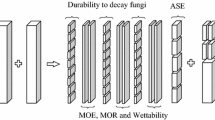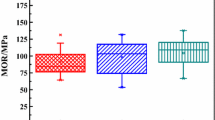Abstract
The purpose of this study was to use furfurylation to enhance the resistance of wood to subterranean termite attack. Wood samples were obtained from four fast-growing tropical wood species, namely sengon (Falcataria moluccana), jabon (Anthocephalus cadamba), mangium (Acacia mangium), and pine (Pinus merkusii), felled at a short cutting rotation. Specimens were impregnated with furfuryl alcohol (FA) solution and tartaric acid as a catalyst and then heated at 100 °C for 24 h. After conditioning, the specimens were exposed to subterranean termite attack in the laboratory according to the Indonesian standard. Furfurylated samples were found to have a higher density presumably because poly-FA filled the void space. It also had a lower moisture content because of the presence of poly-FA bulking in the wood cell wall, making it more hydrophobic. Furfurylation greatly enhanced subterranean termite attack resistance of wood, as shown by remarkably higher termite mortality, higher wood resistance class, lower wood weight percent loss, and reduced termite feeding rate. Based on the Indonesian standard, in which class I indicates very resistant wood and class V indicates very poorly resistant wood, untreated wood was class IV, but all furfurylated wood specimens were rated as class I.



Similar content being viewed by others
References
Acosta AP, Delucis RA, Labidi J, Barbosa KT, Cruz N, Gatto DA (2020) Termite resistance of a fast-growing pine wood treated by in situ polymerization of three different precursors. Forests 11:865. https://doi.org/10.3390/f11080865
Alma MH, Hafizolu H, Maldas D (1996) Dimensional stability of several wood species treated with vinyl monomers and polyethylene glycol-1000. Int J Polym Mater 32:93–99
Arango RA, Green F, Hintz K, Lebow PK, Miller RB (2006) Natural durability of tropical and native woods against termite damage by Reticulitermes flavipes (Kollar). Int Biodeterior Biodegrad 57:146–150
Arinana TK, Herliyana EN, Hadi YS (2012) Termite-susceptible species of wood for inclusion as a reference in Indonesian standardized laboratory testing. Insects 3:396–401
Baysal E, Ozaki SK, Yalinkilic MK (2004) Dimensional stabilization of wood treated with furfuryl alcohol catalysed by borates. Wood Sci Technol 38:405–415
Dong Y, Yan Y, Zhang S, Li J (2014) Wood/polymer nanocomposites prepared by impregnation with furfuryl alcohol and nano-SiO2. BioResources 9(4):6028–6040
Esteves B, Nunes L, Pereira H (2011) Properties of furfurylated wood (Pinus pinaster). Eur J Wood Prod 69:521–525
Fajriani E, Rulle J, Dlouha J, Fournier M, Hadi YS, Darmawan W (2013) Radial variation of wood properties of sengon (Paraserianthes falcataria) and jabon (Anthocephalus cadamba). J Indian Acad Wood Sci 10(2):110–117
Gérardin P (2016) New alternatives for wood preservation based on thermal and chemical modification of wood: a review. Ann For Sci 73(3):559–570. https://doi.org/10.1007/s13595-015-0531-4
Hadi YS, Darma IGKT, Febrianto F, Herliyana EN (1995) Acetylated rubber-wood flakeboard resistance to bio-deterioration. For Prod J 45(10):64–66
Hadi YS, Westin M, Rasyid E (2005) Resistance of furfurylated wood to termite attack. For Prod J 55(11):85–88
Hadi YS, Nurhayati T, Jasni J, Yamamoto H, Kamiya N (2012) Smoked wood resistance to subterranean and dry wood termites attack. Int Biodeterior Biodegrad 70:79–81. https://doi.org/10.1016/j.ibiod.2011.06.010
Hadi YS, Arinana A, Massijaya MY (2014) Feeding rate as a consideration factor for successful termite wood preference tests. Wood and Fiber Sci 46(4):590–593
Hadi YS, Efendi M, Massijaya MY, Arinana A, Pari G (2016a) Subterranean resistance of smoked glued laminated lumber made from fast-growing tree species from Indonesia. Wood and Fiber Sci 48(3):211–216
Hadi YS, Massijaya MY, Arinana A (2016b) Subterranean termite resistance of polystyrene-treated wood from three tropical wood species. Insects 7:37. https://doi.org/10.3390/insects7030037
Hadi YS, Massijaya MY, Zaini LH, Abdillah IB, Arsyad WOM (2018) Resistance of methyl methacrylate-impregnated wood to subterranean termite attack. J Korean Wood Sci Technol 46(6):748–755. https://doi.org/10.5658/WOOD.2018.46.6.748
Hadi YS, Massijaya MY, Zaini LH, Pari R (2019) Physical and mechanical properties of methyl methacrylate–impregnated wood from three fast-growing tropical tree species. J Korean Wood Sci Technol 47(3):324–335. https://doi.org/10.5658/WOOD.2018.46.2.143
Hadi YS, Massijaya MY, Nandika D, Arsyad WOM, Abdillah IB, Setiono L, Amin Y (2020) Color change and termite resistance of fast-growing tropical woods treated with kesambi (Schleichera oleosa) smoke. J Wood Sci 66:61. https://doi.org/10.1186/s10086-020-01906-y
Hermawan D, Hadi YS, Fajriani E, Massijaya MY, Hadjib N (2012) Resistance of particleboards made from fast-growing wood species to subterranean termite attack. Insects 3:532–537. https://doi.org/10.3390/insects3020532
Herold N, Dietrich T, Grigsby WJ, Franich RA, Winkler A, Buchelt B, Pfriem A (2013) Effect of maleic anhydride content and ethanol dilution on the polymerization of furfuryl alcohol in wood veneer studied by differential scanning calorimetry. BioResources 8(1):1064–1075. https://doi.org/10.15376/biores.8.1.10641075
Jia Y, Fiedler B (2018) Influence of furfuryl alcohol fiber pre-treatment on the moisture absorption and mechanical properties of flax fiber composites. Fibers 6(0059):1–14. https://doi.org/10.3390/fib6030059
JIS (2004) Test methods for determining the effectiveness of wood preservatives and their performance requirement. JIS Japanese Industrial Standard, JIS K 1571-2004. Japanese Standard Association, Tokyo
Kanai K, Azuma J, Nishimoto K (1982) Studies on digestive system of termites: I. Digestion of carbohydrates by termite Coptotermes formosanus Shiraki. Wood Res Bull Wood Res Inst Kyoto Univ 68:47–57
Lande S, Westin M, Schneider M (2004) Properties of furfurylated wood. Scand J For Res 19(5):22–30
Li W, Zhang XX, Yu Z, Yu YS, Yu Y (2016) Determining the curing parameters of furfuryl alcohol for wood modification by nanoindentation. Eur J Wood Prod 75:81–87
Martawijaya A, Kartasujana I, Kadir K, Prawira SA (2014) Atlas kayu Indonesia, Jilid II [Indonesian Wood Atlas II], 3rd edn. Forest Products Research Institute, Forestry Department, Bogor
Ministry of Environment and Forestry (2019) Statistic of environment and forestry, Year 2018. Ministry of Environment and Forestry, Jakarta
Moreau C, Belgacem MN, Gandini A (2004) Recent catalytic advances in the chemistry of substituted furans from carbohydrates and in the ensuing polymers. Top Catal 27(1–4):11–30
Morris H, Plavcova L, Cvecko P, Fichtler E, Gillingham MAF, Martınez-Cabrera HI, McGlinn DJ, Wheeler E, Zheng J, Zieminska K, Jansen S (2016) A global analysis of parenchyma tissue fractions in secondary xylem of seed plants. New Phytol 209:1553–1565. https://doi.org/10.1111/nph.13737
Nandika D (2015) Termite attack in the whole country. Termite National Seminar, Jakarta
Pari G (1998) Zat ekstraktif kayu sengon [Extractive of sengon wood]. Duta Rimba 218/XXIII. Perum Perhutani: Jakarta
Schwarze FWMR, Fink S, Deflorio G (2003) Resistance of parenchyma cells in wood to degradation by brown rot fungi. Mycol Prog 2(4):267–274
Sejati PS, Imbert A, Charbonnier CG, Dumarcay S, Fredon E, Masson E, Nandika D, Priadi T, Gerardin P (2017) Tartaric acid catalyzed furfurylation of beech wood. Wood Sci Technol 51(2):379–394. https://doi.org/10.1007/s00226-016-0871-8
Siagian RM, Darmawan S, Saepuloh (1999) Chemical composition of Acacia mangium Willd at several ages harvested from first rotation growth. For Prod Res Bull Indones Ministry For 17(1):57–66
SNI (2006) Wood and wood products resistance test to wood-destroying organism. SNI 7207-2006. Standar Nasional Indonesia [Indonesian National Standard], Indonesian National Standard Bureau: Jakarta
SNI (2014) Wood and wood products resistance test to wood-destroying organism. SNI 7207-2014. Standar Nasional Indonesia [Indonesian National Standard], Indonesian National Standard Bureau: Jakarta
Syofuna A, Banana AY, Nakabonge G (2012) Efficiency of natural wood extractives as wood preservatives against termite attack. Maderas Cienc y Technol 14(2):155–163
Thybring EE (2013) The decay resistance of modified wood influenced by moisture exclusion and swelling reduction. Int Biodeterior Biodegrad 82:87–95
Verma M, Sharma S, Prasad R (2009) Biological alternatives for termite control: a review. Int Biodeterior Biodegrad 63:959–972
Xie Y, Fu Q, Wang Q, Xiao Z, Militz H (2013) Effects of chemical modification on the mechanical properties of wood. Eur J Wood Prod 71:401–416
Acknowledgements
We would like to express our great appreciation to the Indonesian Ministry of Research and Technology, Research and Innovation Agency, Deputy of Research Strengthening and Development which sponsored the research grant. IPB University (Bogor Agricultural University), Bogor, Indonesia, for research facilities, and Salim Hiziroglu from Oklahoma State University USA, for final editing.
Author information
Authors and Affiliations
Corresponding author
Ethics declarations
Conflict of interest
On behalf of all authors, the authors declare that they have no conflict of interest.
Additional information
Publisher's Note
Springer Nature remains neutral with regard to jurisdictional claims in published maps and institutional affiliations.
Rights and permissions
About this article
Cite this article
Hadi, Y.S., Mulyosari, D., Herliyana, E.N. et al. Furfurylation of wood from fast-growing tropical species to enhance their resistance to subterranean termite. Eur. J. Wood Prod. 79, 1007–1015 (2021). https://doi.org/10.1007/s00107-021-01676-4
Received:
Accepted:
Published:
Issue Date:
DOI: https://doi.org/10.1007/s00107-021-01676-4




